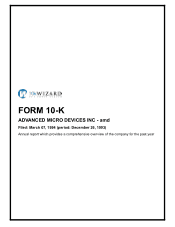AMD 1993 Annual Report Download - page 8
Download and view the complete annual report
Please find page 8 of the 1993 AMD annual report below. You can navigate through the pages in the report by either clicking on the pages listed below, or by using the keyword search tool below to find specific information within the annual report.-
 1
1 -
 2
2 -
 3
3 -
 4
4 -
 5
5 -
 6
6 -
 7
7 -
 8
8 -
 9
9 -
 10
10 -
 11
11 -
 12
12 -
 13
13 -
 14
14 -
 15
15 -
 16
16 -
 17
17 -
 18
18 -
 19
19 -
 20
20 -
 21
21 -
 22
22 -
 23
23 -
 24
24 -
 25
25 -
 26
26 -
 27
27 -
 28
28 -
 29
29 -
 30
30 -
 31
31 -
 32
32 -
 33
33 -
 34
34 -
 35
35 -
 36
36 -
 37
37 -
 38
38 -
 39
39 -
 40
40 -
 41
41 -
 42
42 -
 43
43 -
 44
44 -
 45
45 -
 46
46 -
 47
47 -
 48
48 -
 49
49 -
 50
50 -
 51
51 -
 52
52 -
 53
53 -
 54
54 -
 55
55 -
 56
56 -
 57
57 -
 58
58 -
 59
59 -
 60
60 -
 61
61 -
 62
62 -
 63
63 -
 64
64 -
 65
65 -
 66
66 -
 67
67 -
 68
68 -
 69
69 -
 70
70 -
 71
71 -
 72
72 -
 73
73 -
 74
74 -
 75
75 -
 76
76 -
 77
77 -
 78
78 -
 79
79 -
 80
80 -
 81
81 -
 82
82 -
 83
83 -
 84
84 -
 85
85 -
 86
86 -
 87
87 -
 88
88 -
 89
89 -
 90
90 -
 91
91 -
 92
92 -
 93
93 -
 94
94 -
 95
95 -
 96
96 -
 97
97 -
 98
98 -
 99
99 -
 100
100 -
 101
101 -
 102
102 -
 103
103 -
 104
104 -
 105
105 -
 106
106 -
 107
107 -
 108
108 -
 109
109 -
 110
110 -
 111
111 -
 112
112 -
 113
113 -
 114
114 -
 115
115 -
 116
116 -
 117
117 -
 118
118 -
 119
119 -
 120
120 -
 121
121 -
 122
122 -
 123
123 -
 124
124 -
 125
125 -
 126
126 -
 127
127 -
 128
128 -
 129
129 -
 130
130 -
 131
131 -
 132
132 -
 133
133 -
 134
134 -
 135
135 -
 136
136 -
 137
137 -
 138
138 -
 139
139 -
 140
140 -
 141
141 -
 142
142 -
 143
143 -
 144
144 -
 145
145 -
 146
146 -
 147
147 -
 148
148 -
 149
149 -
 150
150 -
 151
151 -
 152
152 -
 153
153 -
 154
154 -
 155
155 -
 156
156 -
 157
157 -
 158
158 -
 159
159 -
 160
160 -
 161
161 -
 162
162 -
 163
163 -
 164
164 -
 165
165 -
 166
166 -
 167
167 -
 168
168 -
 169
169 -
 170
170 -
 171
171 -
 172
172 -
 173
173 -
 174
174 -
 175
175 -
 176
176 -
 177
177 -
 178
178 -
 179
179 -
 180
180 -
 181
181 -
 182
182 -
 183
183 -
 184
184 -
 185
185 -
 186
186 -
 187
187 -
 188
188 -
 189
189 -
 190
190 -
 191
191 -
 192
192 -
 193
193 -
 194
194 -
 195
195 -
 196
196 -
 197
197 -
 198
198 -
 199
199 -
 200
200 -
 201
201 -
 202
202 -
 203
203 -
 204
204 -
 205
205 -
 206
206 -
 207
207 -
 208
208 -
 209
209 -
 210
210 -
 211
211 -
 212
212 -
 213
213 -
 214
214 -
 215
215 -
 216
216 -
 217
217 -
 218
218 -
 219
219 -
 220
220 -
 221
221 -
 222
222 -
 223
223 -
 224
224 -
 225
225 -
 226
226 -
 227
227 -
 228
228 -
 229
229 -
 230
230 -
 231
231 -
 232
232 -
 233
233 -
 234
234 -
 235
235 -
 236
236 -
 237
237 -
 238
238 -
 239
239 -
 240
240 -
 241
241 -
 242
242 -
 243
243 -
 244
244 -
 245
245 -
 246
246 -
 247
247 -
 248
248 -
 249
249 -
 250
250 -
 251
251 -
 252
252 -
 253
253 -
 254
254 -
 255
255 -
 256
256 -
 257
257 -
 258
258 -
 259
259 -
 260
260 -
 261
261 -
 262
262 -
 263
263 -
 264
264 -
 265
265 -
 266
266 -
 267
267 -
 268
268 -
 269
269 -
 270
270 -
 271
271 -
 272
272 -
 273
273 -
 274
274 -
 275
275 -
 276
276 -
 277
277 -
 278
278 -
 279
279 -
 280
280 -
 281
281 -
 282
282 -
 283
283 -
 284
284 -
 285
285 -
 286
286 -
 287
287 -
 288
288 -
 289
289 -
 290
290 -
 291
291 -
 292
292 -
 293
293 -
 294
294 -
 295
295 -
 296
296 -
 297
297 -
 298
298 -
 299
299 -
 300
300 -
 301
301 -
 302
302 -
 303
303 -
 304
304 -
 305
305 -
 306
306 -
 307
307 -
 308
308 -
 309
309 -
 310
310 -
 311
311 -
 312
312 -
 313
313 -
 314
314 -
 315
315 -
 316
316 -
 317
317 -
 318
318 -
 319
319 -
 320
320 -
 321
321 -
 322
322 -
 323
323 -
 324
324 -
 325
325 -
 326
326 -
 327
327 -
 328
328 -
 329
329 -
 330
330 -
 331
331 -
 332
332 -
 333
333 -
 334
334 -
 335
335 -
 336
336 -
 337
337 -
 338
338 -
 339
339 -
 340
340 -
 341
341 -
 342
342 -
 343
343 -
 344
344 -
 345
345 -
 346
346 -
 347
347 -
 348
348 -
 349
349 -
 350
350 -
 351
351 -
 352
352 -
 353
353 -
 354
354 -
 355
355 -
 356
356 -
 357
357 -
 358
358 -
 359
359 -
 360
360 -
 361
361 -
 362
362 -
 363
363 -
 364
364 -
 365
365 -
 366
366 -
 367
367 -
 368
368 -
 369
369 -
 370
370 -
 371
371 -
 372
372 -
 373
373 -
 374
374 -
 375
375 -
 376
376 -
 377
377 -
 378
378 -
 379
379 -
 380
380 -
 381
381 -
 382
382 -
 383
383 -
 384
384 -
 385
385 -
 386
386 -
 387
387 -
 388
388 -
 389
389 -
 390
390 -
 391
391 -
 392
392 -
 393
393 -
 394
394
 |
 |
4
The Corporation also supplies a range of products specially designed to add
additional functions, improve performance and reduce costs in computer
peripheral, interface or mass storage applications. These are generally
special-purpose products which are optimized for a specific application and are
frequently proprietary products of the Corporation or in the case of selected
large customers, products which have been tailored for that customer.
Networks and Voice/Data Communications. The Corporation provides a wide
variety of products for a broad spectrum of connectivity solutions. These
include applications in central office switches, PBX equipment, voice/data
terminals, and different performance classes of Local Area Networks (LANs) used
to connect workstations and personal computers. In addition to providing the
integrated circuits for these applications, the Corporation also provides
various forms of hardware evaluation tools, development software and interface
software. AMD continues to be a major supplier of Ethernet LAN devices for
workstation applications. During 1993, the Corporation introduced several
Ethernet products designed for use on Personal Computer motherboards and add-in
cards. AMD also is a principal supplier for chip sets to support the
100-megabit-per-second Fiber Distributed Data Interface (FDDI) local area
network standard which is primarily used to connect high performance
workstations and servers. The Corporation has also developed, in cooperation
with systems manufacturers, a family of devices for the 10Base-T standard, which
allows transmission of data using Ethernet protocols on twisted-pair wiring,
rather than on the more expensive coaxial cable.
The Subscriber Line Interface Circuit (SLIC) and the Subscriber Line
Audio-Processing Circuit (SLAC(Trademark)), co-invented and manufactured by the
Corporation, are an integral part of one of the leading designs for digital
telephone switching equipment. The SLIC connects the user's telephone wire to
the telephone company's digital switching equipment. The SLAC is a
coder/decoder which converts analog voice signals to a digital format and back.
The Corporation enjoys its continued success with these products in the
European market, and more recently has seen increased demand from nations
committed to upgrading their telecommunications infrastructure.
High-Volume Commodity Products
Programmable Logic Devices (PLDs). The Corporation is a leading
supplier of high-speed, field-programmable integrated circuits. PLDs generally
afford a user increased design flexibility relative to standard logic devices.
The initial design time and design cost in customizing a programmable device is
significantly less than designing a custom integrated circuit or customizing a
gate array logic device. The Corporation's Programmable Array Logic
(PAL(Registered Trademark)) architecture was invented by Monolithic Memories,
Inc. (MMI), which was acquired by the Corporation in 1987, and AMD's PAL
devices continue to comprise a large share of the worldwide market for
field-programmable logic devices. These devices combine off-the-shelf
availability, ease of use and the low cost of standard products with a
capability for semi-custom design, making them attractive to a broad range of
users. The Corporation's PLDs are generally manufactured with
transistor-to-transistor logic (TTL) designs in bipolar technology for
low-density, high-speed devices, and CMOS for complex architecture,
high-density and low-power devices. In the past several years, the Corporation
has utilized CMOS technology for lower power and more complex architectures.
Programmable devices have generally been manufactured using bipolar
technology to provide users with high-speed products. The Corporation offers
several products using CMOS technology and has continued to expand its product
portfolio in this area.
Non-Volatile/Volatile Memories. Memory components are used to store
computer programs and data entered during system operation. There are two types
of memory storage capability, volatile and non-volatile. Volatile memories
include Dynamic and Static Random Access Memories (DRAMs and SRAMs). Non-
volatile memories retain data when system power is shut off, while volatile
memories do not. Non-volatile memories include Erasable Programmable Read-Only
Memories (EPROMs) and the new generation Flash Memory. The Corporation's memory
products are primarily non-volatile memories used in a wide range of
applications such as PCs, workstations, peripherals, instrumentation, PBX
equipment, avionics and a variety of other equipment where programmed data
storage is needed. The Corporation now has a complete family of
3
Source: ADVANCED MICRO DEVIC, 10-K, March 07, 1994
